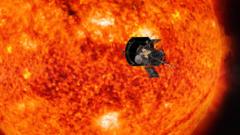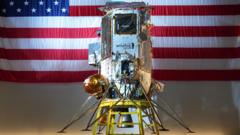The Parker Solar Probe, launched in 2018, is making waves as it attempts to set a new record with its approach to the Sun. This daring fly-by, scheduled for Christmas Eve, will see the probe traverse to just 3.8 million miles (6.2 million km) from the Sun's surface. Despite appearing distant by conventional standards, its proximity is astounding; within a scaled-down model of our solar system, it would measure a mere four centimeters from the Sun. This unprecedented mission aims to unravel long-standing questions about the Sun's outer atmosphere, known as the corona, which has perplexed scientists for decades.
Parker Solar Probe's Record-Breaking Encounter with the Sun

Parker Solar Probe's Record-Breaking Encounter with the Sun
NASA's spacecraft embarks on a historic mission, aiming for the closest approach to our star yet, to unlock solar mysteries.
As the probe dives into this scorching region, it will face daunting challenges including temperatures exceeding 1,400°C and intense radiation that could jeopardize onboard electronics. Shielded by an advanced carbon-composite shield, the Parker Solar Probe will execute its approach with dazzling speed, racing at an astonishing 430,000 mph—the equivalent of traveling from London to New York in less than 30 seconds.
This mission holds significant scientific importance. For years, researchers have struggled to comprehend why the corona, despite being farther from the Sun's core, is much hotter, reaching temperatures into the millions of degrees. Insights gathered from the probe's data, particularly regarding solar wind—the flow of charged particles emanating from the corona—could illuminate interactions with Earth's magnetic field, which are known to create stunning auroras but can also disrupt technology and power systems.
As the probe enters a blackout period, NASA scientists await confirmation of its safe passage, with expectations of receiving a signal on December 27. The ambitious efforts surrounding this fly-by underline the significance of understanding solar dynamics, as knowledge gleaned could have profound implications for life on Earth. With anticipation mounting, the mission exemplifies humanity's relentless pursuit of knowledge and exploration beyond our planet.
This mission holds significant scientific importance. For years, researchers have struggled to comprehend why the corona, despite being farther from the Sun's core, is much hotter, reaching temperatures into the millions of degrees. Insights gathered from the probe's data, particularly regarding solar wind—the flow of charged particles emanating from the corona—could illuminate interactions with Earth's magnetic field, which are known to create stunning auroras but can also disrupt technology and power systems.
As the probe enters a blackout period, NASA scientists await confirmation of its safe passage, with expectations of receiving a signal on December 27. The ambitious efforts surrounding this fly-by underline the significance of understanding solar dynamics, as knowledge gleaned could have profound implications for life on Earth. With anticipation mounting, the mission exemplifies humanity's relentless pursuit of knowledge and exploration beyond our planet.


















